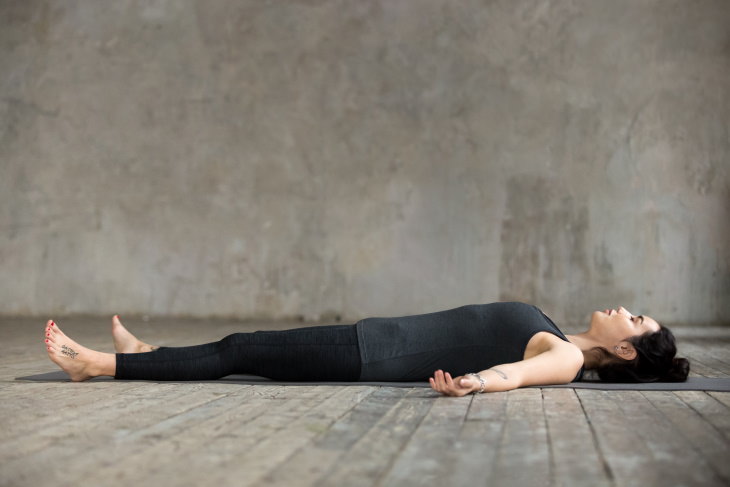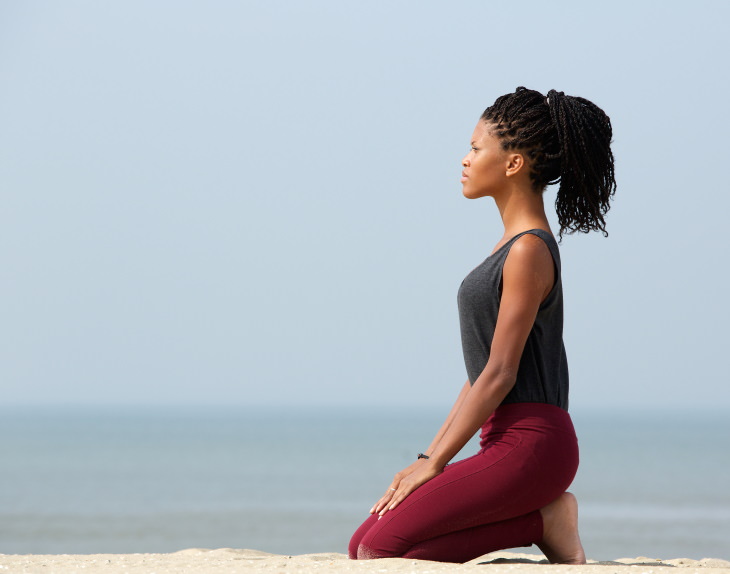1. Lying Down
Let's start with the meditation position we can all comfortably do - a lying down position. Those of you who have ever tried to do yoga will recognize this position as savasana, or the corpse pose, as it's an essential asana in yoga that finalizes each yoga practice. But a lying-down position isn't just reserved for yoga, anyone can meditate in savasana.
Do keep in mind that meditating this way can make you drowsy, and you'll need to focus on your breath and pay attention to different areas in your body to maintain an active mind and not fall asleep. An excellent technique to practice is a body scan, where you focus on one body part at a time moving your attention up from your fingertips and to the top of your head.
Though you might think you need no directions to savasana, alignment is crucial even in this seemingly simple pose. Here are some points to consider:
- Start from rolling out a yoga mat or thick blanket on the floor and laying down comfortably on your back. A small pillow or yoga block can be used to prop up the head if necessary.
- Stretch out your legs and lay you back flat against the floor, feel the support of the floor.
- Your hands can be also stretched out wide and up like a starfish. Alternatively, you can put one hand on your stomach and the other on your chest to observe how your body moves when you breathe.
- Once you found a comfortable and relaxing position, you can start the body scan or focus on your breath.
2. Sitting Meditation
Any comfortable sitting position can become your go-to meditation pose. You can fold your legs in a criss-cross position or even sit on a chair if sitting on a floor, block or cushion isn't comfortable for you. The most important element to consider isn't the position you're sitting in, but rather how straight your spine is in that position because slouching will not allow you to sit comfortably and breathe deeply.
If you're sitting on a yoga mat or blanket and feel like it's difficult for you to sit straight and you feel pulling or discomfort in the lower back, you can raise your pelvis above the knees by sitting on a pile of books, a yoga block, or a cushion. Once you find a comfortable position, either in a chair or on the floor, raise your chest and drop your shoulders down to extend the spine even further and gaze slightly higher than your nose level to keep your neck straight, too.
Lay your hands on your thighs, knees, or wherever they naturally fall. Relax your jaw, lower the chin slightly, and close your eyes. You should feel the support of the floor and feel comfortable as you start breathing deeply and start meditating.
3. Kneeling Position
If you feel that sitting on the floor is pressing on your tailbone or is difficult on your spine, you can try the kneeling position, which makes it easier to maintain a straight spine while meditating. Do keep in mind that this position can be difficult for those with knee problems and you can feel a strong stretch in the feet when you first begin meditating in this position.
You can ease the stress on the knees and feet by propping both up with a blanket or pillow. In this position, it's important to relax your shoulders and keep the gaze straight not to put any excess weight on the knees. Those with knee injuries or problems with the feet should avoid this position.
4. Standing Meditation
The last suggestion we'll leave you with is a standing meditation practice. While this position may make it difficult for some people to relax and go into a state of deep meditation, it also has many benefits. For one, it's easier on the spine, knees, and feet, as it doesn't require a lot of flexibility. Standing meditation is also beneficial for those whose mind tends to wander and you easily fall asleep or get distracted while meditating in other positions, as standing will require more mental focus. Lastly, standing meditation will help strengthen your body in the long run.
To meditate in a standing position, follow these tips:
- Set your feet at shoulder-width apart, bend the knees slightly, and feel how this helps your feet stay firmly on the ground.
- You can activate your core muscles a bit to help straighten the spine and get the energy going. Then relax your shoulders and neck, gazing straight to maintain a straight spine.
- Put your hands together in a prayer position at the level of your heart to help maintain focus. Press the hands slightly against each other to open up the chest area.
When meditating in a standing position, we would advise not to close your eyes. Instead, focus on one specific object - a focal point - this will help you maintain balance in the body. Meditating in any position, an interesting point to remember is to focus on the sensations in the body. Find the parts of the body where you feel tension or pain, and use your deep exhales to ease that tension.




